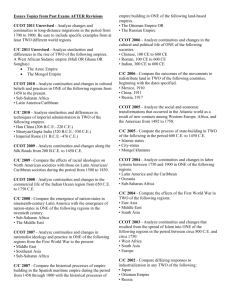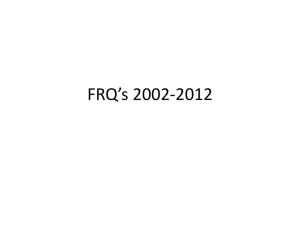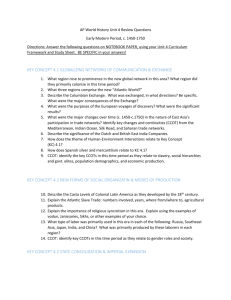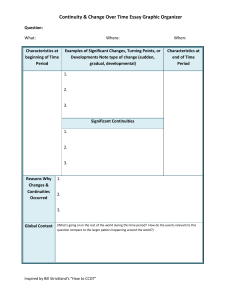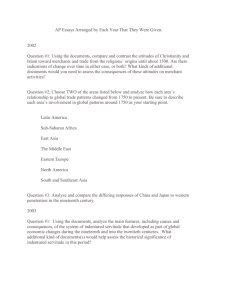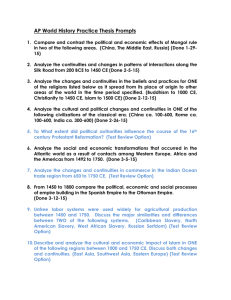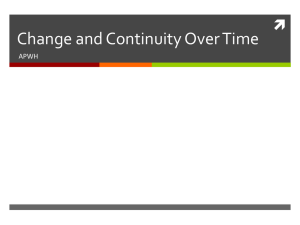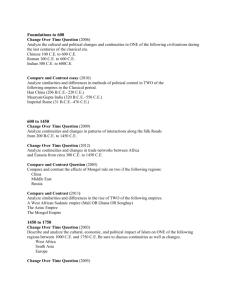APWH Released Essay Questions
advertisement
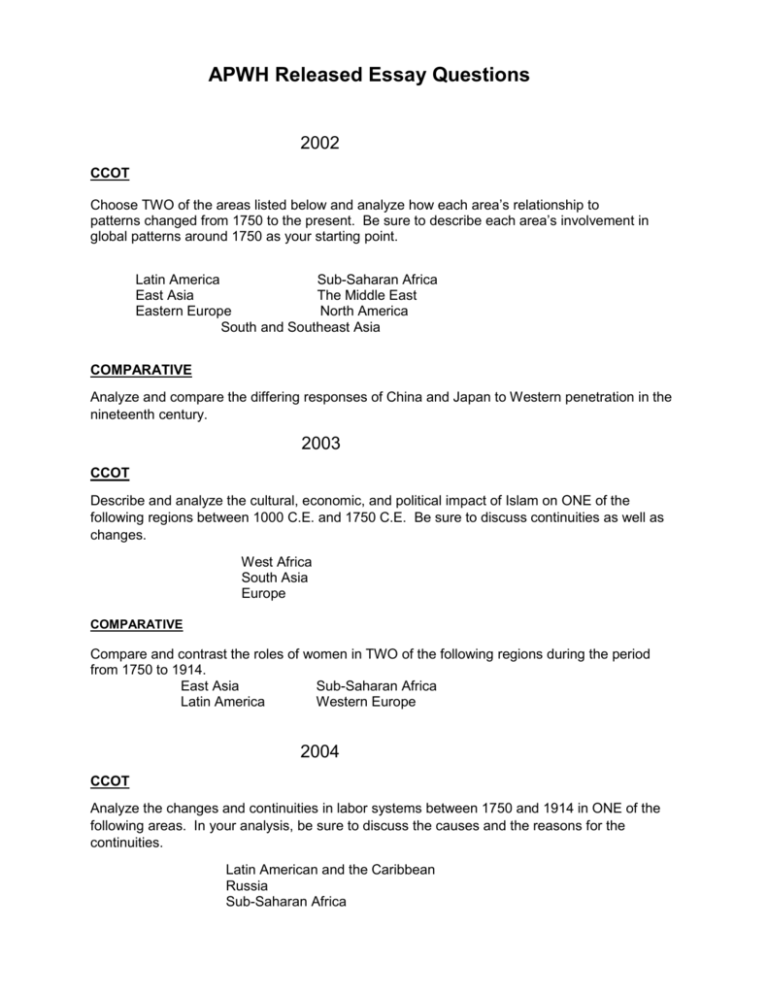
APWH Released Essay Questions 2002 CCOT Choose TWO of the areas listed below and analyze how each area’s relationship to patterns changed from 1750 to the present. Be sure to describe each area’s involvement in global patterns around 1750 as your starting point. Latin America Sub-Saharan Africa East Asia The Middle East Eastern Europe North America South and Southeast Asia COMPARATIVE Analyze and compare the differing responses of China and Japan to Western penetration in the nineteenth century. 2003 CCOT Describe and analyze the cultural, economic, and political impact of Islam on ONE of the following regions between 1000 C.E. and 1750 C.E. Be sure to discuss continuities as well as changes. West Africa South Asia Europe COMPARATIVE Compare and contrast the roles of women in TWO of the following regions during the period from 1750 to 1914. East Asia Sub-Saharan Africa Latin America Western Europe 2004 CCOT Analyze the changes and continuities in labor systems between 1750 and 1914 in ONE of the following areas. In your analysis, be sure to discuss the causes and the reasons for the continuities. Latin American and the Caribbean Russia Sub-Saharan Africa COMPARATIVE Compare and contrast how the First World War and its outcomes affected TWO of the following regions in the period from the war through the 1930’s. 2005 CCOT Analyze the social and economic transformations that occurred in the Atlantic world as a result of new contacts among Western Europe, Africa, and the Americas from 1492 to 1750. COMPARATIVE Compare and contrast the political and economic effects of Mongol rule on TWO of the following regions: China Middle East Russia 2006 CCOT Analyze the cultural and political changes and continuities in ONE of the following civilizations during the last centuries of the classical era. Chinese, 100 C.E. to 600 C.E. Roman, 100 C.E. to 600 C.E. Indian, 300 C.E. to 600 C.E. COMPARATIVE Compare and contrast the goals and outcomes of the revolutionary process in TWO of the following countries, beginning with the dates specified. Mexico China Russia 1910 1911 1917 2007 CCOT Analyze major changes and continuities in the formation of national identities in ONE of the regions listed below from 1914 to the present. Be sure to include evident from specific countries in the region selection. Middle East Southeast Asia Sub-Saharan Africa COMPARATIVE Within the period from 1450 to 1800, compare the processes (e.g., political, social, economic) of empire building in the Spanish Empire with the empire-building in ONE of the following. The Ottoman Empire OR The Russian Empire 2008 CCOT Analyze the changes and continuities in commerce in the Indian Ocean region from 650 C.E to 1750 C.E. COMAPARATIVE Compare the emergence of nation-states in nineteenth-century Latin America with the emergence of nation-states in ONE of the following regions in the twentieth century. Sub-Saharan Africa The Middle East 2009 CCOT Analyze continuities and changes in patterns of interactions along the Silk Roads from 200 B.C.E. to 1450 C.E. COMPARATIVE For the period from 1500 to 1830, compare North American racial ideologies and their effects on society with Latin American/Caribbean racial ideologies and their effects on society. 2010 CCOT Describe and explain continuities and changes in religious beliefs and practices in ONE of the following regions from 1450 to the present. Sub-Saharan Africa Latin America/Caribbean COMPARATIVE Analyze similarities and differences in methods of political control in TWO of the following empires in the Classical Period. Han China (206 B.C.E.-220 C.E.) Mauryan/Gupta India (320 B.C.E.-550 C.E.) Imperial Rome (31 B.C.E-476 C.E.) 2011 CCOT Analyze changes and continuities in long-distance migrations in the period from 1700 to 1900. Be sure to include specific examples from at least TWO different world regions. COMPARATIVE Analyze similarities and difference in the rise of TWO of the following empires. A West African Sudanic empire (Mali OR Ghana OR Songhai) The Aztec Empire The Mongol Empire 2012 CCOT Analyze changes and continuities in trade networks between Africa and Eurasia from circa 300 C.E to 1450 C.E. COMPARATIVE Compare demographic and environmental effects of the Columbian Exchange on the Americas with the Columbian Exchange’s demographic and environmental effects on ONE of the following regions between 1492 and 1750. Africa Asia Europe 2013 CCOT Analyze how political transformations contributed to continuities and changes in the cultures of the Mediterranean region during the period circa 200 C.E. to 1000 C.E. COMPARATIVE Analyze similarities and differences between the role of the state in Japan’s economic development and role of the state in the economic development of ONE of the following during the late nineteenth and early twentieth centuries. China Ottoman Empire Russia
